Rear Brake Rotor Replacement 1500 Series w/NYS, 25/3500 Series
Tools Required
Caution: Refer to Brake Dust Caution in the Preface section.
Removal Procedure

- Release the park brake, if necessary.
- Inspect the fluid level in the brake master cylinder reservoir.
- If the fluid level is midway between the maximum - full point, and
the minimum allowable level, no fluid needs to be removed from the reservoir before
proceeding.
- If the fluid level is higher than midway between the maximum - full
point, and the minimum allowable level, remove fluid to the midway point before proceeding.
- Remove the tire and wheel assembly. Refer to
Tire and Wheel Removal and Installation
in Tires and Wheels.
- Mark the relationship of the rotor to the hub.
- Compress the brake caliper pistons.
| 7.1. | Install a large C-clamp over the top of the caliper housing and against
the back of the outboard pad. |
| 7.2. | Slowly tighten the C-clamp until the pistons are pushed completely into
the caliper bores. |
| 7.3. | Remove the C-clamp from the caliper. |
Notice: Refer to Brake Caliper Notice in the Preface section.

- Remove the brake caliper bracket bolts.
- Remove the caliper and caliper bracket as an assembly.
Support
the caliper with heavy mechanic's wire or equivalent. DO NOT disconnect the hydraulic
brake flexible hose from the caliper.
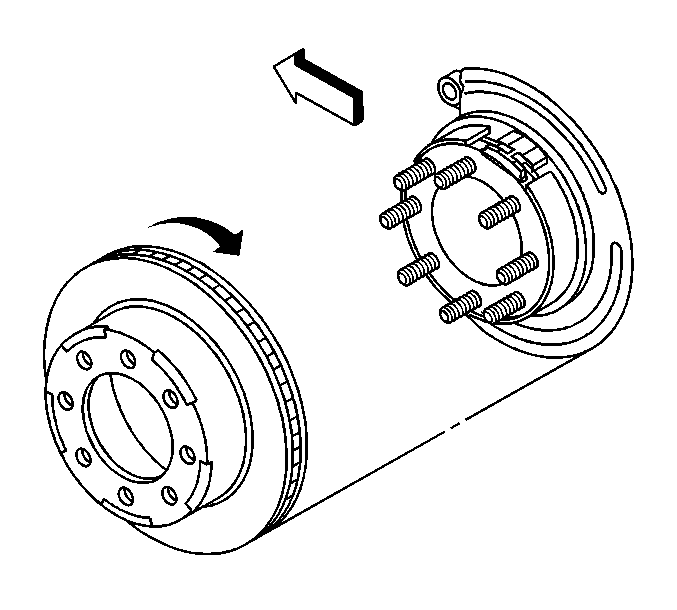
- Remove the brake rotor retaining push nuts
from the wheel studs, if applicable.
- It may be necessary to strike the end of the hub or the rotor with a deadblow
hammer to separate the rotor from the hub.
- Remove the rotor by slowly turning the rotor while pulling the rotor away
from the axle.
Installation Procedure
Important: Whenever the brake rotor has been separated
from the hub/axle flange, any rust or contaminants should be cleaned from the hub/axle
flange and the brake rotor mating surfaces. Failure to do this may result in excessive
assembled lateral runout (LRO) of the brake rotor, which could lead to brake pulsation.
- Use the J 42450-A
to clean
all rust and contaminants from the mating surface of the hub flange.
- Use the J 41013
to clean all rust and contaminants from the inside diameter of the hat section of
the brake rotor to prevent any foreign material from getting between the brake rotor
and the hub flange.
- Inspect the mating surfaces of the hub/axle flange and the rotor to ensure
that there are no foreign particles or debris remaining.
- Align the rotor to its original position on the hub, if applicable.

- Install the rotor by slowly turning the
rotor while pushing the rotor towards the axle.
- If the rotor was removed and installed as part of a brake system repair,
measure the assembled lateral runout (LRO) of the rotor to ensure optimum performance
of the disc brakes. Refer to
Brake Rotor Assembled Lateral Runout Measurement
.
- If the rotor assembled LRO measurement exceeds the specification, bring
the LRO to within specifications. Refer to
Brake Rotor Assembled Lateral Runout Correction
.

- Install the caliper and caliper bracket
as an assembly.
- Perform the following procedure before installing the brake caliper bracket
bolts.
| 9.1. | Remove all traces of the original adhesive patch. |
| 9.2. | Clean the threads of the bolts with brake parts cleaner or the equivalent
and allow to dry. |
| 9.3. | Apply Threadlocker GM P/N 12345493 (Canadian P/N 10953488)
to the threads of the bolts. |
Notice: Refer to Fastener Notice in the Preface section.
- Install the brake caliper bracket bolts.
Tighten
Tighten the bolts to 300 N·m (221 lb ft).
- Install the tire and wheel assembly. Refer to
Tire and Wheel Removal and Installation
in Tires and Wheels.
- Lower the vehicle.
- With the engine OFF gradually apply the brake pedal to approximately 2/3
of its travel distance.
- Slowly release the brake pedal.
- Wait 15 seconds then repeat steps 15-16 until a firm
pedal is obtained. This will properly seat the caliper pistons and pads.
- Fill the master cylinder reservoir to the proper level with clean brake
fluid, if necessary. Refer to
Master Cylinder Reservoir Filling
in Hydraulic Brakes.
Rear Brake Rotor Replacement 1500 Series w/o NYS
Tools Required
Caution: Refer to Brake Dust Caution in the Preface section.
Removal Procedure
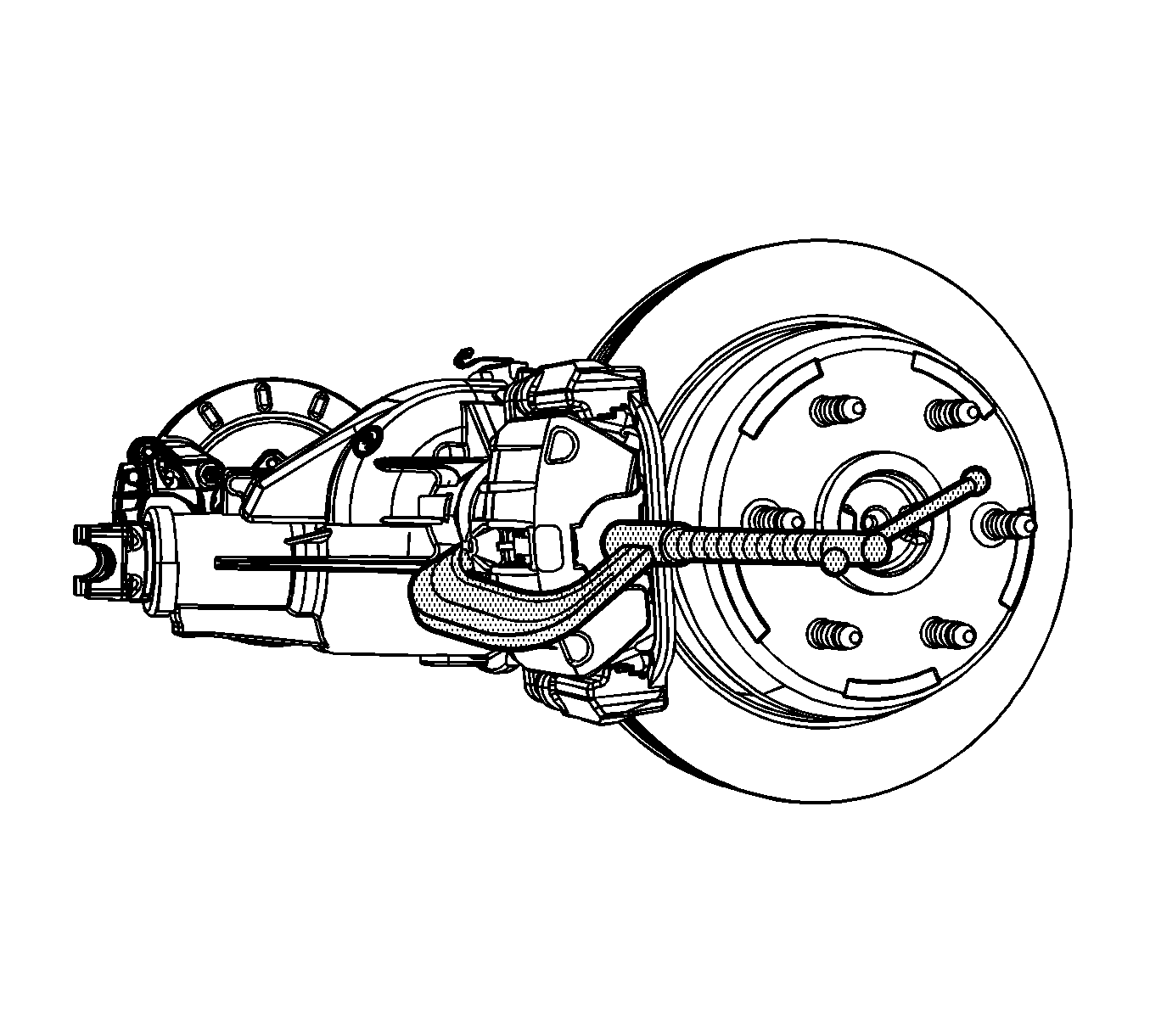
- Release the park brake, if necessary.
- Inspect the fluid level in the brake master cylinder reservoir.
- If the fluid level is midway between the maximum - full point, and
the minimum allowable level, no fluid needs to be removed from the reservoir before
proceeding.
- If the fluid level is higher than midway between the maximum - full
point, and the minimum allowable level, remove fluid to the midway point before proceeding.
- Remove the tire and wheel assembly. Refer to
Tire and Wheel Removal and Installation
in Tires and Wheels.
- Mark the relationship of the rotor to the hub.
- Compress the brake caliper pistons.
| 7.1. | Install a large C-clamp over the top of the caliper housing and against
the back of the outboard pad. |
| 7.2. | Slowly tighten the C-clamp until the pistons are pushed completely into
the caliper bores. |
| 7.3. | Remove the C-clamp from the caliper. |

- Remove the brake caliper bracket bolts.
Notice: Refer to Brake Caliper Notice in the Preface section.

- Remove the caliper and caliper bracket as an assembly.
Support
the caliper with heavy mechanic's wire or equivalent. DO NOT disconnect the hydraulic
brake flexible hose from the caliper.
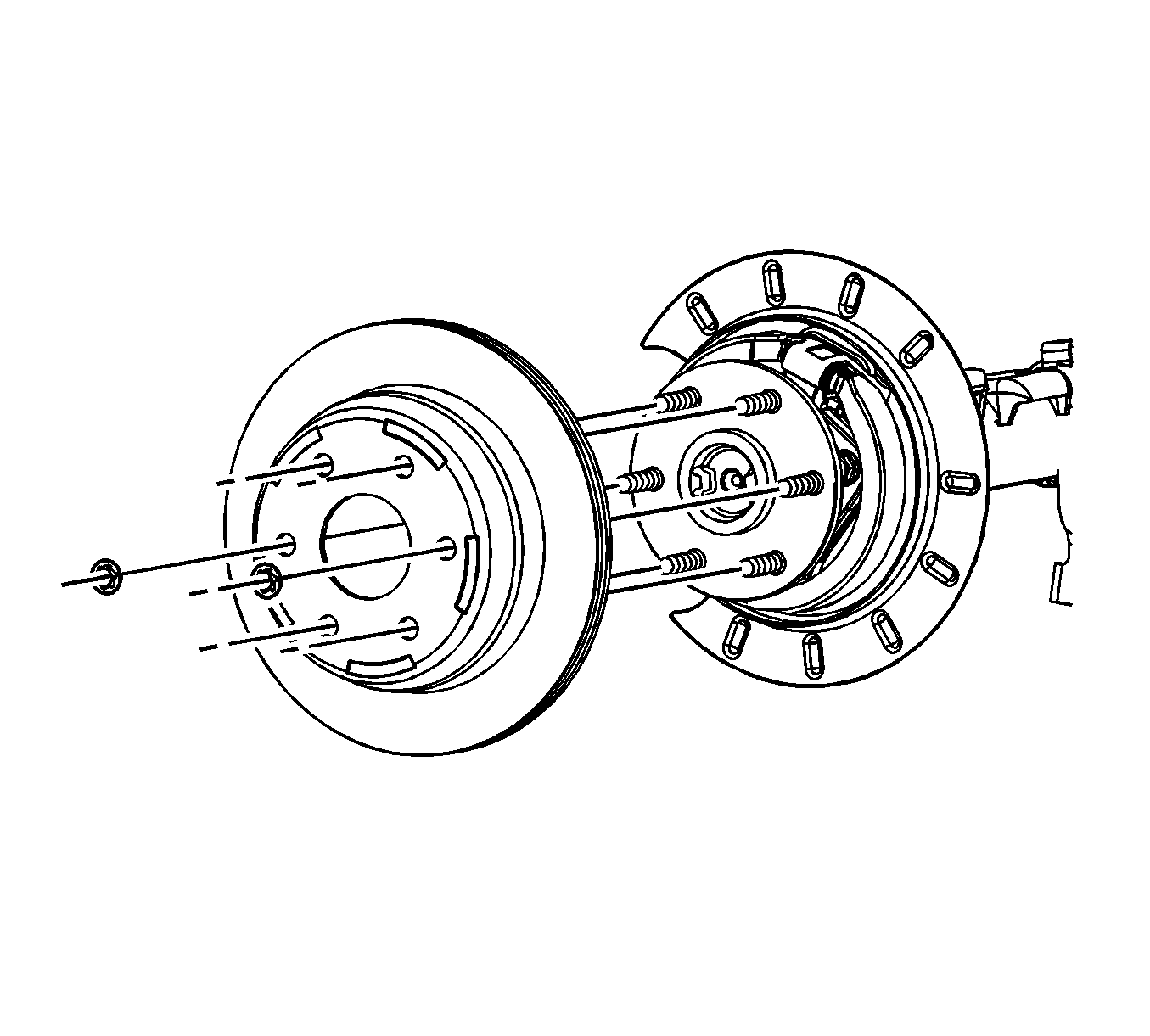
- Remove the brake rotor retaining push nuts
from the wheel studs, if applicable.
- It may be necessary to strike the end of the hub or the rotor with a deadblow
hammer to separate the rotor from the hub.
- Remove the rotor by slowly turning the rotor while pulling the rotor away
from the axle.
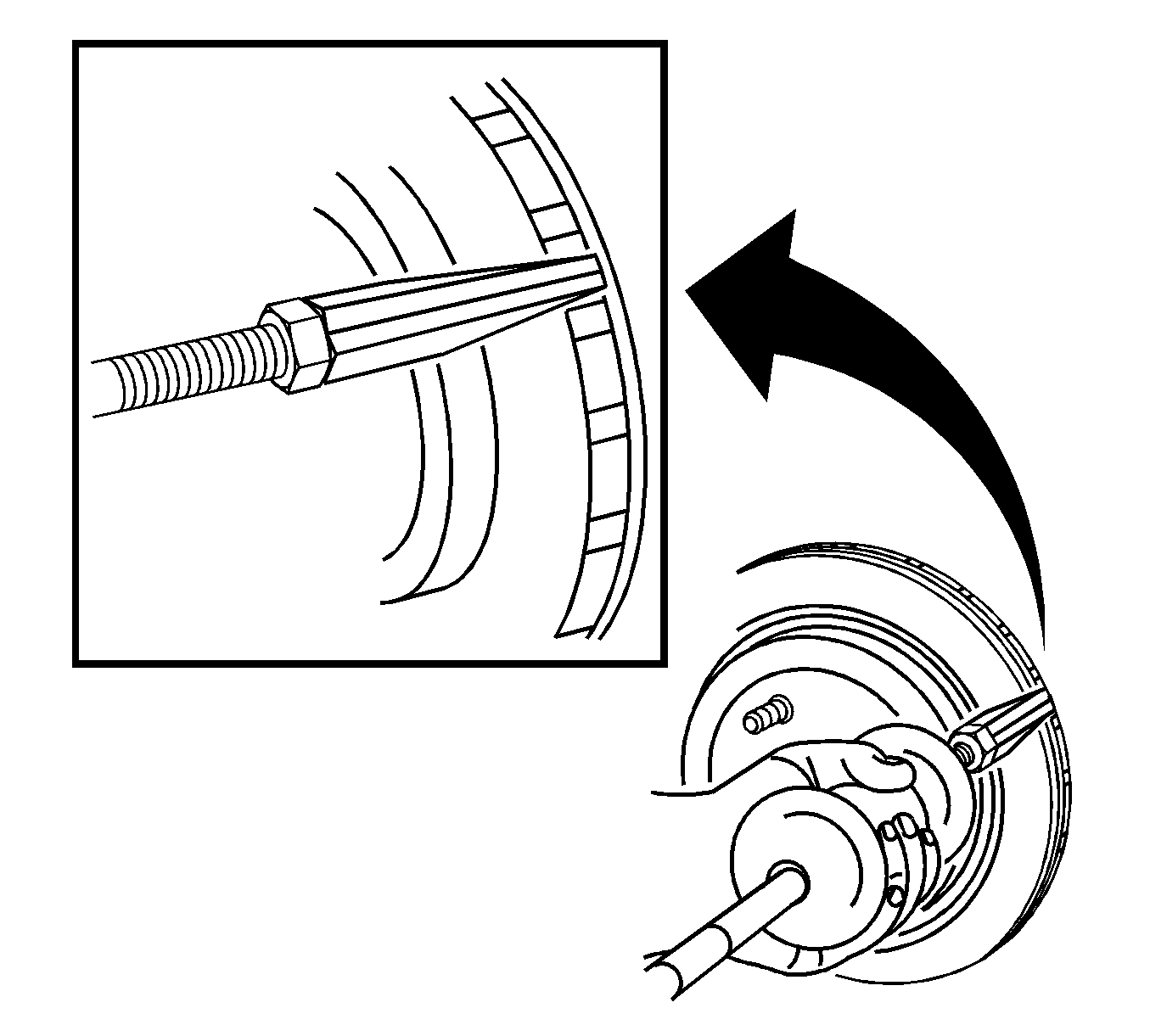
- If the brake rotor cannot be removed, perform
the following:
| 13.2. | Insert J-46277
between the rotor friction surfaces in the vent section of the rotor. |
DO NOT place the J-46277
on
the rotor friction surface.
| 13.4. | Inspect the park brake components for the following conditions: |
| • | Bent or broken hold down spring |
| • | Broken, cracked or worn brake shoe lining |
| • | Bent or damaged brake shoe |
| • | Worn, bent or damaged back plate |
| 13.5. | If any of these conditions are found replace the affected parts. |
Installation Procedure
Important: Whenever the brake rotor has been separated
from the hub/axle flange, any rust or contaminants should be cleaned from the hub/axle
flange and the brake rotor mating surfaces. Failure to do this may result in excessive
assembled lateral runout (LRO) of the brake rotor, which could lead to brake pulsation.
- Use the J 42450-A
to clean
all rust and contaminants from the mating surface of the hub flange.
- Use the J 41013
to
clean all rust and contaminants from the inside diameter of the hat section of the
brake rotor to prevent any foreign material from getting between the brake rotor and
the hub flange.
- Inspect the mating surfaces of the hub/axle flange and the rotor to ensure
that there are no foreign particles or debris remaining.
- Align the rotor to its original position on the hub, if applicable, and
install the rotor.
- If the rotor was removed and installed as part of a brake system repair,
measure the assembled lateral runout (LRO) of the rotor to ensure optimum performance
of the disc brakes. Refer to
Brake Rotor Assembled Lateral Runout Measurement
.
- If the rotor assembled LRO measurement exceeds the specification, bring
the LRO to within specifications. Refer to
Brake Rotor Assembled Lateral Runout Correction
.

- Install the brake rotor by slowly turning
the rotor while pushing the rotor towards the axle.

- Install the caliper and caliper bracket
as an assembly.

- Perform the following procedure before installing
the caliper bracket bolts.
| 9.1. | Remove all traces of the original adhesive patch. |
| 9.2. | Clean the threads of the bolt with brake parts cleaner or the equivalent
and allow to dry. |
| 9.3. | Apply Threadlocker GM P/N 12345493 (Canadian P/N 10953488)
to the threads of the bolt. |
Notice: Refer to Fastener Notice in the Preface section.
- Install the brake caliper bracket bolts.
Tighten
Tighten the bolts to 200 N·m (148 lb ft).
- Install the tire and wheel assembly. Refer to
Tire and Wheel Removal and Installation
in Tires and Wheels.
- With the engine OFF, gradually apply the brake pedal to approximately 2/3
of its travel distance.
- Slowly release the brake pedal.
- Wait 15 seconds, then repeat steps 13-14
until a firm pedal is obtained. This will properly seat the caliper pistons and
pads.
- Fill the master cylinder reservoir to the proper level with clean brake
fluid, if necessary. Refer to
Master Cylinder Reservoir Filling
in Hydraulic Brakes.
Rear Brake Rotor Replacement 25/3500 Series w/Dual Wheels
Caution: Refer to Brake Dust Caution in the Preface section.
Removal Procedure
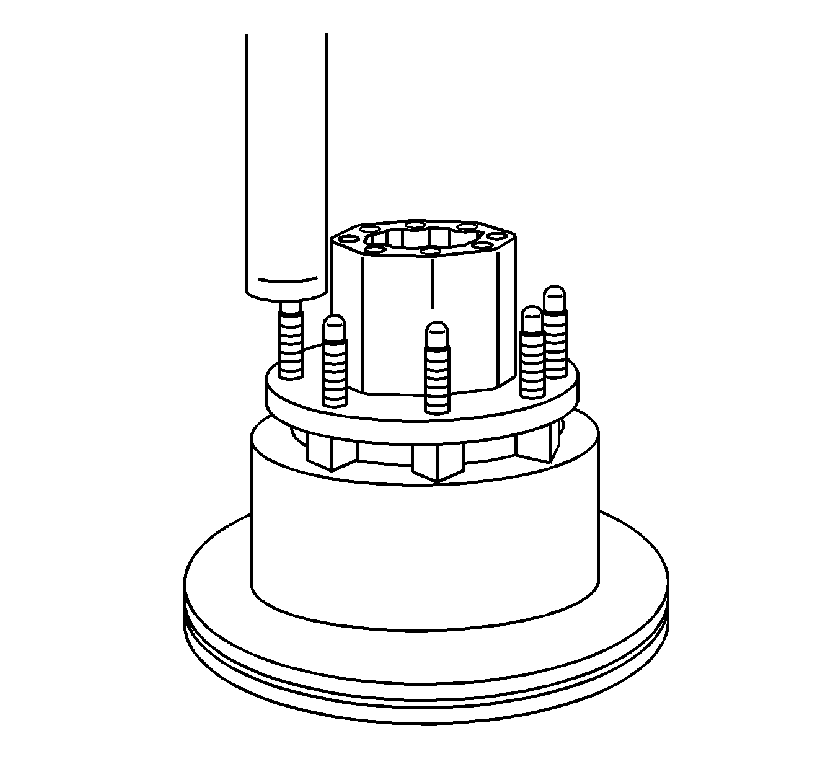
- Release the park brake, if necessary.
- Remove the hub and rotor assembly. Refer to
Rear Axle Hub, Bearing, Cup, and/or Seal Replacement
in Rear Drive Axle.
- Mark the relationship of the hub to the rotor.
- Place the hub and rotor on a hydraulic press.
- Press the wheel studs out of the hub and rotor.
Installation Procedure

- Align
the hub and the rotor (if applicable).
- Install each of the new wheel studs into the hub and rotor by performing
the following steps:
| 2.2. | Install 4 washers to the stud. |
| 2.3. | Install a lug nut to the stud with the flat side of the nut towards the
washers. |
| 2.4. | Tighten the lug nut to draw the stud into the hub and rotor. |
| 2.5. | Inspect the hub and rotor to ensure that the hub is tight against the
rotor and the stud is seated completely. |
| 2.6. | Remove the lug nut and the washers. |
- Install the hub and rotor assembly to the vehicle. Refer to
Rear Axle Hub, Bearing, Cup, and/or Seal Replacement
in Rear Drive Axle.
- With the engine OFF, gradually apply the brake pedal to approximately 2/3
of its travel distance.
- Slowly release the brake pedal.
- Wait 15 seconds, then repeat steps 6-7 until a firm
pedal is obtained. This will properly seat the brake caliper pistons and brake pads.
- Fill the master cylinder reservoir to the proper level with clean brake
fluid, if necessary. Refer to
Master Cylinder Reservoir Filling
in Hydraulic Brakes.















